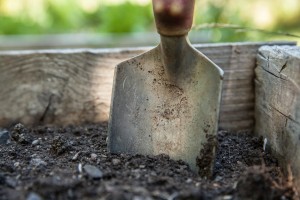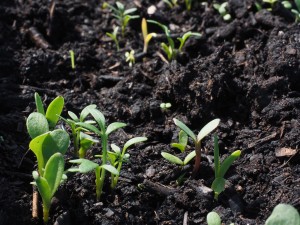Many gardeners in our area have made the trip to the local nursery this spring to purchase fertilizer for their lawn or garden. Standing in front of the array of options can be daunting to say the least.
There are 20 essential chemical elements (plant nutrients) known to be required for plant growth. These elements can be supplied by either organic or commercial inorganic fertilizers. Strangely, the most heavily utilized nutrients are not purchased or applied. The three most utilized nutrients are carbon, hydrogen, and oxygen. These big three come from just the air and water that exist naturally around most every plant. Nitrogen from organic and inorganic sources is the fourth plant nutrient.
These four (carbon, hydrogen, oxygen, and nitrogen) make up 95% of plant solids.
The other 16 essential elements, iron, calcium, phosphorus, potassium, copper, sulfur, magnesium, manganese, zinc, boron, chlorine, molybdenum, cobalt, sodium, silicon and vanadium, are supplied to plants by the soil. With the exception of nitrogen and phosphorus, most alkaline, clay type soils usually contain enough of these elements for vegetable production. In acid sandy soils, nitrogen, phosphorus, potassium, calcium, magnesium and, at times, sulfur and boron may need to be added for successful crop production. Cobalt, sodium, silicon, and vanadium have been proven essential for only a few plants.
Fertilizer bags are labeled with at least three numbers. These numbers list the percentage of nitrogen (N), available  phosphate (as P2O5) and soluble potash (as K2O). These numbers represent nitrogen, phosphorous and potassium, commonly referred to as N-P-K. However, these elements are symbolically represented as N-P2O5-K2O. For example, if we have a 100 pound bag of fertilizer labeled 10-10-10, it contains 10 pounds of N, 10 pounds of P2O5, and 10 pounds of K2O.
phosphate (as P2O5) and soluble potash (as K2O). These numbers represent nitrogen, phosphorous and potassium, commonly referred to as N-P-K. However, these elements are symbolically represented as N-P2O5-K2O. For example, if we have a 100 pound bag of fertilizer labeled 10-10-10, it contains 10 pounds of N, 10 pounds of P2O5, and 10 pounds of K2O.
The other 70 pounds is filler or carrier which is important to help spread the fertilizer evenly and avoid burning plants with too much fertilizer. A 100 pound bag of fertilizer labeled 0-20-10 would contain no N, 20 pounds of P2O5, 10 pounds of K2O and 70 pounds of filler or carrier. The other 70% consists of filler material, usually an inert material like clay. Other parts of the nutrient carrier may be other elements associated with the nitrogen, phosphorous, and potassium such as hydrogen, oxygen, calcium, and chloride.
Nitrogen is a major nutrient of all plant life and of all the elements required for plants to grow, nitrogen is given the most credit for making plants green and vegetative. Without nitrogen, plants will appear yellow and will produce less growth. If nitrogen had a personality, I’d call it fickle and flighty – unable to hold a job or stay in any long term relationship. Honestly, nitrogen’s natural state is as a gas. It wants to be free and, well, be a gas. We simply want it to stay in the soil in a form that a plant ca
n absorb it.
 Phosphorous would be the fella that you invited over to your house to watch a ballgame that just doesn’t know when to leave. Though the nutrient is crucial for seed germination as well as root, flowering and fruit development, you can easily get too much of this guy. He can stay way past his time and will get in the way. Indeed, too much phosphorous in the soil with bind up other nutrients and keep them from even being available for plants to take up.
Phosphorous would be the fella that you invited over to your house to watch a ballgame that just doesn’t know when to leave. Though the nutrient is crucial for seed germination as well as root, flowering and fruit development, you can easily get too much of this guy. He can stay way past his time and will get in the way. Indeed, too much phosphorous in the soil with bind up other nutrients and keep them from even being available for plants to take up.
Of the list of other nutrients, there are many times that certain chemical nutrients will play a major role. Too little calcium be a major factor in blossom end rot on tomatoes. Pecan trees respond very well to zinc, but only when sprayed on the leaves. Clovers respond well to a little boron yet too much can be toxic!
So, just how much and what kind of fertilizer should your lawn, garden, hay meadow or other field need? One can only make an educated guess without getting your soil tested. Testing costs $10 per sample. Soil test bags and forms can be downloaded by searching “SFA soil sample form” or are available from your local County Extension office.








